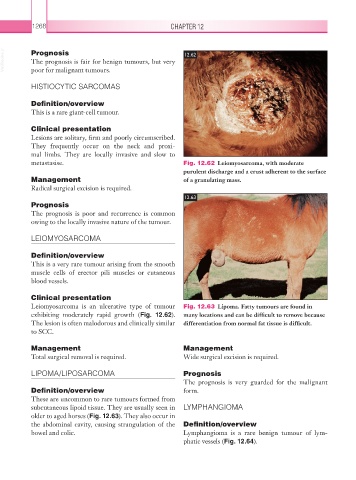Page 1293 - Equine Clinical Medicine, Surgery and Reproduction, 2nd Edition
P. 1293
1268 CHAPTER 12
VetBooks.ir Prognosis 12.62
The prognosis is fair for benign tumours, but very
poor for malignant tumours.
HISTIOCYTIC SARCOMAS
Definition/overview
This is a rare giant-cell tumour.
Clinical presentation
Lesions are solitary, firm and poorly circumscribed.
They frequently occur on the neck and proxi-
mal limbs. They are locally invasive and slow to
metastasise. Fig. 12.62 Leiomyosarcoma, with moderate
purulent discharge and a crust adherent to the surface
Management of a granulating mass.
Radical surgical excision is required.
12.63
Prognosis
The prognosis is poor and recurrence is common
owing to the locally invasive nature of the tumour.
LEIOMYOSARCOMA
Definition/overview
This is a very rare tumour arising from the smooth
muscle cells of erector pili muscles or cutaneous
blood vessels.
Clinical presentation
Leiomyosarcoma is an ulcerative type of tumour Fig. 12.63 Lipoma. Fatty tumours are found in
exhibiting moderately rapid growth (Fig. 12.62). many locations and can be difficult to remove because
The lesion is often malodorous and clinically similar differentiation from normal fat tissue is difficult.
to SCC.
Management Management
Total surgical removal is required. Wide surgical excision is required.
LIPOMA/LIPOSARCOMA Prognosis
The prognosis is very guarded for the malignant
Definition/overview form.
These are uncommon to rare tumours formed from
subcutaneous lipoid tissue. They are usually seen in LYMPHANGIOMA
older to aged horses (Fig. 12.63). They also occur in
the abdominal cavity, causing strangulation of the Definition/overview
bowel and colic. Lymphangioma is a rare benign tumour of lym-
phatic vessels (Fig. 12.64).

